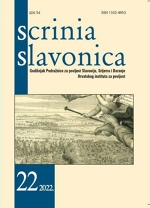STEFAN ŠTILJANOVIĆ – OD KAŠTELANA DO DESPOTA I SVECA (prvi dio)
Stefan Štiljanović – From a Castellan to a Despot and Saint (Part 1)
Author(s): Petar SeletkovićSubject(s): Political history, Social history, 15th Century, The Ottoman Empire
Published by: Hrvatski institut za povijest
Keywords: Stefan Štiljanović; anti-Ottoman defense system; Ladislas Móré; Serbian elite; Kingdom of Hungary; Hungarian nobility; castellans; Middle Ages;
Summary/Abstract: This paper has endeavoured to open a number of issues significant for the understanding of the period at the end of the Middle Ages in the territory of present-day Slavonia and Syrmia and further afield, the southern areas of Hungary along the border with the Ottoman Empire. Using the example of Stefan Štiljanović, who embarked on a significant career in the service of the magnate Ladislas Móré de Cula on his grand estates south of the Drava River and at the same time gained respect by serving on the border with the Ottomans and warring with the supporters of King Ivan Zapoljski, successfully performing important military and intelligence duties for the Hungarian anti-king of Ferdinand Habsburg, this paper has endeavoured to raise the question of the social mobility, that is to say the social advancement of individuals from the ranks of the middle and lower stratum of the Hungarian nobility and the members of immigrating Serbian and other Southern Slavic (military) elites, which, due to their military service on the border with the Ottomans entered the ranks of the Hungarian nobility. In contrast to earlier times, the circumstances of the Ottoman advancement and the conquest of certain parts of southern Hungary and at the same time the war between the supporters of the two Hungarian anti-kings increased the opportunities for individuals from the middle and lower strata of the Hungarian society to achieve fast social advancement by acquiring new estates; a large number of these estates had previously been taken from the opposite side. Thus, for example King Ferdinand Habsburg bestowed upon Stefan Štiljanović the estates of Miholjanec and Glogovnica in Križevci County, which had previously been taken from knez Petar Mrsinjski, a supporter of King John Zapolja. In 1535 Ferdinand made a deed of gift of the estate of Esztyén (presumably near the present-day village of Stejanovci in Serbia) in the Syrmia County to Štiljanović; this estate had previously been owned by knez Lovro Iločki and was at that particular time situated in the Ottoman territory. Stefan Štiljanović acquired noble status in 1527, and in the grant from 1535 he already bore the title of egregius, which means that he made further progress on the social scale and most likely became a member of the middle or county nobility. In addition to the opportunity for rapid ascent, in the circumstances of the Ottoman invasion and the war of counter-kings, the dangers of losing status, property, and even life for all layers of the Hungarian nobility and society increased significantly at the same time.
Journal: Scrinia Slavonica
- Issue Year: 2022
- Issue No: 22
- Page Range: 9-41
- Page Count: 33
- Language: Croatian

